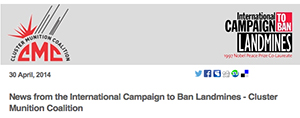28 June 2016
The Korean Exception and the Mine Ban Treaty

"The Korea Exception to the Mine Ban Treaty & Obama's Last Days in Office," panelists Eleana Kim, Professor of Anthropology at UC Irvine, Megan Burke, Director of the ICBL, and Channapha Khamvongsa, Executive Director of Legacies of War (USCBL member). Also on the panel but not shown was Jae-kook Cho, Professor at Yonsei University and Director of the Korean Campaign to Ban Landmines. Photo Credit: Legacies of War
On Thursday, 23 June 2016, ICBL Director, Megan Burke, spoke to academics, researchers and activists working at the Korea Summit in Washington DC. The Summit was organized and hosted by the Korean Peace Network, the Elliott School of International Affairs' Partnership for International Strategies in Asia and the American Friends Service Committee for organizing the "Summit on North Korea." Her remarks follow:
The 1997 Mine Ban Treaty bans the use, production, stockpiling and transfer of antipersonnel mines and places obligations on countries to clear affected areas, assist victims and destroy stockpiles. The Mine Ban Treaty is widely recognized as one of the most successful disarmament treaties with over 80% of the world’s countries on board. There are 162 States Parties and just 35 States remaining outside the treaty.
The Mine Ban Treaty’s wide acceptance has contributed to a strong norm against any use or production of landmines. As a result, even among those States who have yet to join the treaty, most are in de facto compliance with all or most of the treaties obligations and the use of landmines is almost completely limited to use by non state armed actors. In addition to the United States, which I will discuss below, other examples of such compliance by non state actors include:
- In 2010 Russia declared that it has destroyed 10 million mines, including antipersonnel mines
- In 2014 China informed us that currently it stockpiles five million antipersonnel mines, a great reduction from the 110 million previously cited by the Landmine Monitor
- Morocco has formally said several times that it is in de facto compliance with the MBT
The Korean Exception
One major exception to this is South Korea, not a state party to the treaty, which continues to produce antipersonnel landmines, at least as recently as 2011, and maintain a stockpile believed to contain anywhere from 500,000 to 2 million ap mines. This places South Korea among a group of just 11 countries with the potential to produce landmines and one of just four countries (along with India, Myanmar and Pakistan) where there is believed to be active production. In addition, the demilitarized zone separating North and South Korea and the Civilian Control Zone, just south of the DMZ, are among the most heavily mined areas in the world.
However, even South Korea has been influenced by the strong norm against the use of landmines: South Korea has stated that it has not put new mines in place in many years and it has had a moratorium in place prohibiting the export of AP mines since 1997. In addition, in 2014, South Korea’s National Assembly passed the Special Support Law for Civilian Landmine Victims. This law provides for compensation to landmine survivors and the families of the deceased and support for medical expenses. The bill also authorizes the government to provide funds to non-profit associations or organizations working to improve the livelihoods or well-being of landmine survivors or families of those people killed. It came about after years of advocacy by the ICBL’s South Korean campaign and should help the estimated 500- 1,000 civilian survivors of landmine incidents.
US Landmine Policy
The current landmine situation in South Korea directly influences US landmine policy. While, in 1994, President Clinton called for the elimination of anti personnel landmines, the United States still remains outside of the Mine Ban Treaty. In October 2014, the US announced the latest changes in this policy, aligning it with all key obligations of the Treaty except as it relates to the Korean peninsula. The US would not:
- Use any ap landmines
- Assist or encourage any actor from producing, transferring or using landmines
And would destroy all stockpiled ap mines—except for those needed for the defense of South Korea.
Already, in June of 2014, the US had announced its policy forswearing future production or acquisition of antipersonnel landmines.
This US government considers this new policy a “further step to advance the humanitarian aims of the Ottawa Convention and to bring U.S. practice in closer alignment with a global humanitarian movement that has had a demonstrated positive impact in reducing civilian casualties from APL.” In announcing the policy, President Obama also pledged: “to continue to work to find ways that would allow us to ultimately comply fully and accede to the Ottawa Convention.” However, no timeframe was provided for the US government’s eventual accession to the Mine Ban Treaty.
Information published by the White House presenting the new policy explained the Korean exception by stating that “the unique circumstances on the Korean Peninsula and our commitment to the defense of the Republic of Korea preclude us from changing our anti-personnel landmine policy there at this time. We will continue our diligent efforts to pursue material and operational solutions that would be compliant with and ultimately allow us to accede to the Ottawa Convention while ensuring our ability to meet our alliance commitments to the Republic of Korea. The security of the Republic of Korea will continue to be a paramount concern as we move forward with these efforts.”
During the US landmine policy review, two concerns were raised in relation to the US role in South Korea’s defense. First, the fact that US-South Korean military arrangements allow for joint command structures in the case of active conflict, putting US military personnel in charge of South Korean forces. This would create conflicting legal restrictions for mine use if the US were to join the treaty while South Korea remained outside. Second, the US military held that the US might have to use ap mines if North Korea were to invade.
This, despite several retired US military officials who question the utility of antipersonnel mines in South Korea and the availability of a range of other military options that are seen as sufficient to compensate for not using mines. For example, the former US commander of US forces in South Korea, Lt. Gen James Hollingsworth stated in 1997 that any limited utility of ap landmines in South Korea was offset by the risks they posed for US soldiers given military strategy that prized the mobility and quick maneuverability of soldiers.
Policy versus Practice
In fact, the 2014 policy announcements, made official what has already been the practice in the US for many years.
Use
Since 1991, the US has used just 1 landmine, a single munition planted in Afghanistan in 2002. The last large scale use of mines by the US was in the 1991 Persian Gulf War.
The US has no minefields in place anywhere in the world since it completed the clearance of landmines from around Guantanamo Naval Base in 1999.
Production
No U.S. antipersonnel landmines have been produced since 1997.
Stockpiles
While the US still has landmines stockpiled, it has begun to destroy these stocks. In 2002, it announced having over 10 million mines stocked. In June 2014, it announced that these stocks are now around 3 million mines in stocks.
Export
US law has prohibited all ap mine exports since October of 1992, through a comprehensive moratorium. Given that the US was a major exporter from 1969 to 1992, the end of US exports has had a huge impact in drastically reducing the global trade in ap mines to almost nothing.
More generally, US policy influences many other countries. De facto compliance and the revised policy greatly contribute to the stigmatization of landmine use. However, full accession to the treaty would have a greater and more permanent impact on ending all use of ap landmines.
ICBL Campaign Objectives
- Elimination of the Korean exception in the US landmine policy
- Calls on President Obama to send the accession of the Mine Ban Treaty to the US senate for advice and consent
- Encourages the U.S. to support South Korean mine victims and consider supporting mine clearance in a section of the DMZ as suggested by the Korea Peace Network of civil society groups
- Encourages both South and North Korea to jointly become members of the Mine Ban Treaty and use the clearance of the DMZ as a means to forge improved relations for the mutual protection of their populations.


